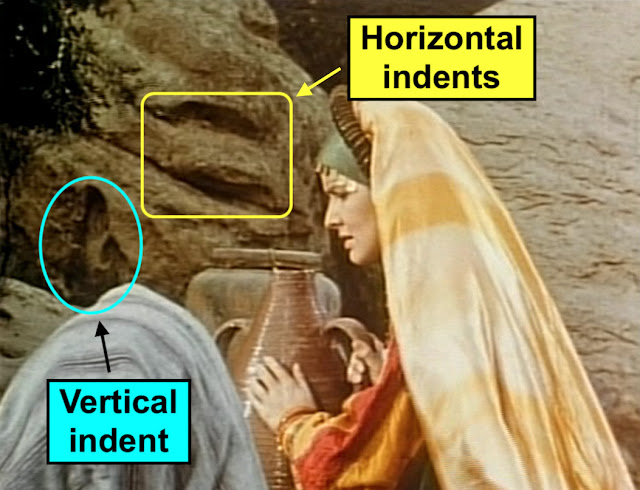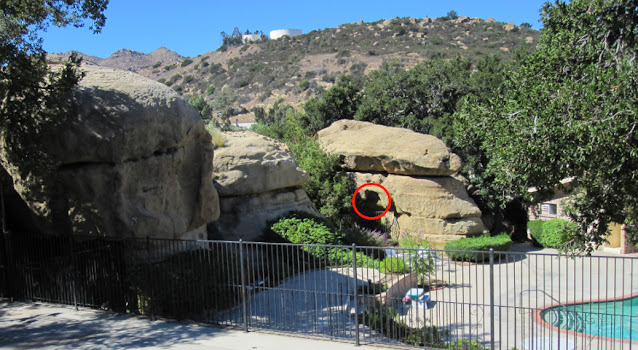Jesus, played by Nelson Leigh, at "Jacob's Well" in 1952
The Bible story about Jesus' encounter with a Samaritan woman at Jacob's Well was brought to life in the early 1950s in a film series by the Christian-oriented production company Family Films.
The "Jesus met the woman at the well" story was filmed in what is now the swimming pool area of the Indian Hills Mobile Home Village in Chatsworth, Calif. At the time the location was part of the Iverson Movie Ranch.
The scene is included in a 12-episode series of Bible stories that first came out in 1952 and has been repackaged over the years and marketed in a variety of formats under various titles. One of the most common versions appears on a DVD set under the title "The Living Bible Collection."
Another variation is "The Bible Series: Jesus the Christ," which can typically be found on DVD on eBay and other websites. The series has also been released as "The Life of Christ," while individual chapters also have multiple titles and have been edited to various chapter lengths for the different releases.
Adding to the confusion, a "rival" studio, Cathedral Films, produced its own series of Bible stories under similar titles around the same time. Cathedral's "Living Christ Series" was not filmed on the Iverson Ranch and is not the same production as Family Films' "The Life of Christ," "The Living Bible" or "The Bible Series: Jesus the Christ."
In this post we'll focus on the Family Films production, one major Bible series of the early 1950s that WAS filmed on the Iverson Movie Ranch — and for simplicity, we'll just call it "The Living Bible."
Jesus meets the woman at the well — Notice the rock at top right
Here we find Jesus chatting with the Samaritan woman, and we see not only Jacob's Well — the concrete-looking structure behind Jesus and the woman — but also a distinctive rock in the background.
The rock has two prominent horizontal indentations, which will be useful in helping us identify the same rock in other shots — and in turn should help pinpoint the filming location for the Jacob's Well sequence.
This shot from the Jacob's Well encounter provides a slightly closer look at the rock, and also reveals another distinctive marker.
Near the base of the rock on its left side, we can see another indent, this one more vertical in orientation.
Here's a shot of that same rock from a different angle and in a different production, the old serial "Secret Service in Darkest Africa." I refer to this rock as "Walnut," based on its overall shape and general appearance.
The screen shot from "Secret Service in Darkest Africa" again shows those two distinctive horizontal indentations on Walnut, even though this is a different angle from the "Living Bible" shot.
Walnut can be found in quite a few movies and TV shows, including the Johnny Mack Brown B-Western "Six-Gun Gospel." The big rock on the right is Walnut.
Unfortunately, Walnut no longer exists, having been destroyed to make way for the rec center at the Indian Hills complex. For more about Walnut and some of its neighbors, please click here.
Also seen in the "Six-Gun Gospel" screen shot is Tilted Cube, which was one of the closest neighbors to Walnut. Unlike Walnut, Tilted Cube did survive development — click here for a little more about that part of the story.
Here's a much different view of Walnut, essentially from the opposite side. That's Walnut at top center, and also visible in this shot is the "back side" of Tilted Cube, on the left.
From this angle, Walnut actually looks more like a tilted cube than Tilted Cube does — a fact that also complicated the search for the real Tilted Cube in today's landscape.
Tilted Cube doesn't look nearly as much like a tilted cube from this angle. It's much less orderly on this side, really just a big mess of a rock.
This is what that "messy" side of Tilted Cube looks like in the modern landscape. This photo, which I took from the swimming pool area in 2013, shows how close Tilted Cube is to the rec center.
To get a better sense of the scale of some of these old movie rocks, note that today Tilted Cube rises well above the roof of the rec center — and Walnut was several times larger than Tilted Cube.
For another illustration of how these big rocks size up, consider this shot of Walnut and some of its neighbors in the season five "Lone Ranger" episode "The Return of Don Pedro O'Sullivan."
Pointing out the obvious, this is Walnut, outlined here in blue.
Less obvious is Tilted Cube, dwarfed by its camera-hogging neighbor, Walnut. Their size difference is exaggerated here by Walnut's being closer to the camera, but even so, Walnut is a much larger rock.
Here's another shot of Walnut's "back side," which includes a vertical indentation we discussed previously — the dark area on the rock, to the right of the fighter.
It's a little hard to see here, but this indentation is the same one near the base of Walnut that we pointed out in "The Living Bible."
Here's the same indentation as it appears in "The Living Bible."
In another shot from "Secret Service in Darkest Africa," we again see the back side of Walnut at top center, along with Tilted Cube to its left.
As we've noted, the two rocks were close neighbors. In this case Tilted Cube is closer to the camera, but even so, the larger Walnut makes its presence felt.
The shot also features a third rock, which I call Johnny Crawford Rock. Like Tilted Cube, Johnny Crawford Rock has survived and remains in place today in the Indian Hills Mobile Home Village.
The name "Johnny Crawford Rock" comes from a 1961 episode of "The Rifleman" called "First Wages," in which Crawford, as young Mark McCain, rides next to the rock.
Something to note about Johnny Crawford Rock is that it has a distinctive marker that is almost an exact duplicate of the vertical indentation we've been seeing on Walnut.
Johnny Crawford Rock also appears in this shot we looked at previously of Jesus leading a group through the swimming pool area. Here again we see the rock's vertical indentation.
Today Johnny Crawford Rock is part of the landscaping around the swimming pool at the Indian Hills Mobile Home Village in Chatsworth, Calif.
The rock's prominent vertical indentation remains a part of the modern landscape.
A wider shot of the swimming pool area again shows Johnny Crawford Rock, toward the right, along with some other old movie rocks. All of these rocks appeared frequently in movies and on television.
Here again, Johnny Crawford Rock's indentation is pretty easy to spot.
Taking another look at the Jacob's Well set in "The Living Bible," we again see an indentation in a rock behind Jesus and the Samaritan woman — but this is not the same rock we've been looking at.
As we've noted previously, this is NOT the indentation in Johnny Crawford Rock — it's the oddly similar indentation in nearby Walnut.
Ideally we could get a look at the indentations on both Johnny Crawford Rock and Walnut in the same shot, but the closest thing I've seen is this shot featuring both rocks, along with their neighbor Tilted Cube.
The three rocks line up nicely in the shot, and by examining their positions relative to each other, we can determine that the Jacob's Well set in "The Living Bible" would have been located in the swimming pool area.
The "Blazing Bullets" shot includes Walnut's indentation, marked here in red, but a tree prevents us from getting a clear look at Johnny Crawford Rock's matching marker, mostly hidden in the yellow outline.
In the end, the rocks confirm that the Jacob's Well encounter in "The Living Bible" was filmed approximately where the Indian Hills Mobile Home Village's swimming pool is located today.



















-Tilted%20Cube%20next%20to%20rec%20center-7098.JPG)























No comments:
Post a Comment